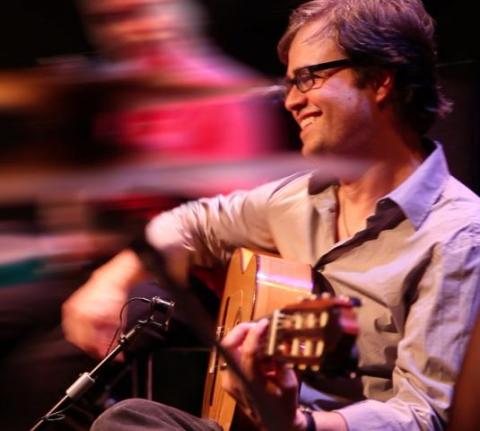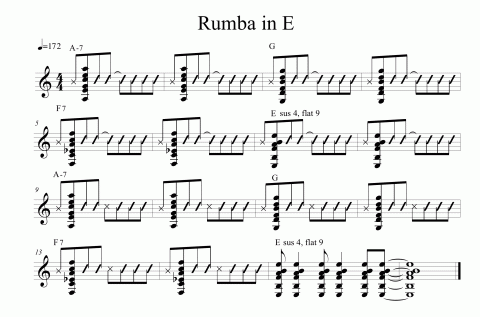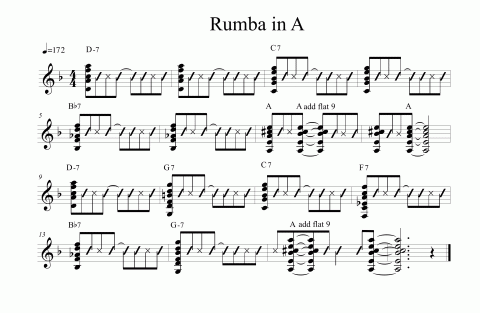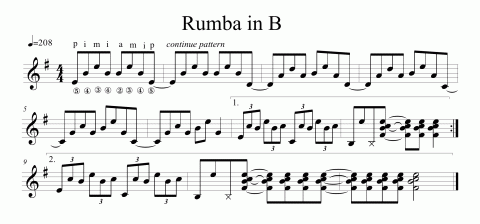Rumba: A Gateway to Flamenco
By Kai Narezo '99

Kai Narezo
I've always thought of the rumba, one of the many palos or styles of flamenco, as a sort of gateway to flamenco music. It's often the first kind of flamenco people hear that pulls them into what turns out to be an amazing musical world that goes way beyond this accessible form. The rumba is basically the pop version of flamenco.
Rumba's Past and Present
The rumba is one of what are called the Cantes de ida y vuelta, musical forms brought from the new world to Spain, which were adopted and adapted by flamencos. More recently, groups like Ketama and La Barbería del Sur have adopted salsa, Brazilian, and jazz so that contemporary rumba sounds much less like the Gypsy Kings and more like Latin jazz-pop.
Flamenco is folk music at heart. Like other genres—such as the blues—flamenco has been elevated in sophistication and virtuosity by its more talented exponents. But it is simultaneously a form that is sung, played, and danced at parties and in homes throughout Spain without the need of virtuosity or musical education.
The rumba falls into the category of cante chico, or light song, and unlike the majority of the flamenco palos, it has very loose parameters. It's basically anything played or sung in 4/4 time and can be in major or minor keys as well as what I'll call flamenco Phrygian (more on that below). Perhaps the most common distinguishing feature is a slightly pronounced accent on the and of beat 2, and weaker accent on the downbeat, though it is also common to hear strong beats 1 and 3.
Popularized outside of Spain by the Gypsy Kings and Rodrigo y Gabriela, the right-hand patterns in example 1 involve a muting slap across the strings that strikes the body of the guitar, usually on beat 1 or on beats 1 and 3, along with an accent on the and of 2 and occasionally on the and of 4. Example 2 is a variation of example 1 without the slap. Example 3 is a common arpeggio pattern that can be used for rumba, but it's more a point of departure than a standard pattern. Example 4 combines an arpeggio pattern and contemporary rumba pattern without the slap.
A misconception about flamenco stemming from the rumba, is the idea that flamenco is about a couple of guitarists jamming over a chord progression. While Paco de Lucia's hit “Entre dos aguas” and his work with Al DiMeola and John McLaughlin made flamenco appeal to guitarists worldwide, the truth is that improvised soloing over a set of changes is still a rarity in flamenco. It's more the province of Nouveau Flamenco as played primarily by non-Spaniards such as German guitarist Ottmar Liebert and Canadian Jesse Cook. They have borrowed much of the sound of flamenco and much less of the substance.
Chord Progressions and Scales
The Phrygian scale is characteristic in flamenco, but the flamenco Phrygian scale differs slightly from the traditional Phrygian mode. Example 2a shows the Flamenco Phrygian scale.
The chord progression that defines flamenco Phrygian is D-, C, Bb, A add b9. In flamenco music, it's common to hear the chord progressions beginning not on the I chord (A), but on the IV (D minor). The I chord comes at the end of the progression. Many non-flamenco musicians would think of the tonal center as D minor, which I'm calling the IV chord. But there is justification for considering A as the I chord because the music always resolves to A.
Note that we arrive at an A-major chord at the end of this progression rather than an A-minor chord, which we would derive from the strictly modal A Phyrigian scale. The flamenco Phryigian scale gives us both the flatted third and the natural third as options. The bII chord (Bb) can be played as a triad, dominant seventh, or even a major 7th chord. The bIII chord (C), is typically played as a triad or a dominant seventh chord. Again, you don't necessarily want to derive scales too specifically from these chords. The IV chord (d minor) makes more sense to the Berklee-trained ear, and the C#, or major third of the A chord, gives us the option of using D harmonic minor as a chord scale.
The bII (Bb) has the #11 and, more often than not, the seventh degree will be flatted, but in flamenco music, you wouldn't typically use a Lydian flat-7 scale here. If we play the Bb as a Maj7#11 chord, it will sound more like a substitution for the IV chord rather than a bII with Lydian leanings. It's common to insert secondary dominants along with basic chord-type substitutions for the bII chord. With substitutions, the progression could go D-, G7, C7, F7, Bb, G-, A. (See example 2.)
Flamenco Keys
Although the current generation of flamenco players is decidedly more musically literate than its predecessors, an old habit that remains is that of referring to various keys by names other than their actual key names. That's because capos are ubiquitous in flamenco for the purpose of changing keys for the singer and because of how the guitar sounds when capoed. Regardless of how the placement of the capo changes the actual key, chord progressions that resolve to an E chord form are called Por Arriba (see example 1) and those that resolve to an A form are Por Medio (see example 2). The main difference between the various flamenco keys lies in the voicings that result from the open strings. Other common flamenco keys are F#, B, and Eb. Additionally, flamenco guitarists may employ some alternate tunings.
Conclusion
As with Brazilian styles, it's relatively easy to borrow the sound of flamenco without knowing too much about the specific styles. Approaching rumba by playing a Phrygian scale with its added natural third over a progression of A-, G, F, E (add b9), and learning how this rhythm swings is a great starting point. There's a rich and complex world of rhythms and harmonies that is inaccessible without a commitment to listening to and learning the huge variety of flamenco styles, the history, and the cante (singing), which is the foundation of flamenco and the true inspiration for most flamenco guitarists.
I recommend exploring the recordings of singer Camarón de la Isla, who was to the cante what Paco de Lucia was to the guitar in the flamenco revolution of the second half of the 20th Century. Other great singers include Antonio Mairena, Enrique Morente, Diego el Cigala, Jose Merce, and Carmen Linares. Guitarists will be amazed at the accompaniment on any recordings by these singers. They give a taste of what flamenco is really all about.
Kai Narezo, a flamenco performer and teacher from Los Angeles, released the CD Contra Tiempo. He coauthored A Compás: The Flamenco Guitar Survival Guide with Scott Wolf. Visit kainarezo.com.

Example 1.

Example 2

Example 2a

Example 3

Example 4
All musical examples by Kai Narezo © 2016, all rights reserved.




